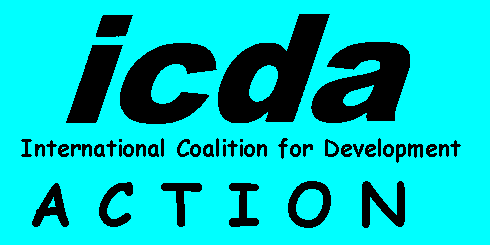
This site is best viewed with
| ICDA LATEST |
ICDA Latest News
Programme areas
ICDA History
| ICDA MEMBERS |
Current Members
| WTO IMPACT LIST |
Subscribe Here
What do you think?
| CENNT |
Latest News
IWGGT (in construction)
| PUBLICATIONS |
Latest ICDA Journal (in construction)
Latest ICDA Update (in construction)
| VACANCIES |
Internship
Book Keeper/Part time administrative Assistant
| HELP |
FAQ's
About Us
Contact Us

| REGIONAL TRADE >> WHERE DOES INDIA FIT ON THE WORLD STAGE? |
| By: ELISABETH PAULSON |
"the [Indian] government has made great strides in opening its market to the flows of trade and ideas—usually for the better. From April 2000, the government began axing more than a thousand import restrictions, well ahead of the timetable required by the WTO after India lost a case brought by the US."
For years India couldn't quite figure out its place on the world stage. Was it the leader of the developing world, standing up to the voracious globalizers at the World Trade Organization, the International Monetary Fund and the White House? Or, like China, was it a poor but powerful member of the global big league, throwing its weight around and playing by the rules when its suits? Other nations face such dilemmas. Americans bicker about whether to be the world's policeman or its biggest fortress. China seesaws between belligerence and regional beneficence. And what do those countries have in common with India? A firm sense that they are "or should be" significant players on the world stage.
India's current government, led by the Bharatiya Janata Party (BJP), has begun posturing as a world power. The shock testing of nuclear weapons in 1996 was India's unsolicited bid for membership in the globe's most exclusive club. A string of foreign governments dumped scorn on India's clumsy attempt to join, and its role in heightening tensions with neighboring Pakistan.
To the chagrin of anti-nuclear activists around the world, Delh's strategy seems to have partly worked. India has been noticed; especially in Washington, where the Clinton administration redefined and improved relations between the former Cold War antagonists. Happily for India, the White House's dealings with Delhi are no longer confined to ongoing troubles with Pakistan over Kashmir. Nuclear testing isn't the only reason for this re-evaluation. India's potential as a counterfoil to China and a partner in the battle against terrorism (read: Osama bin Laden) also play a role. Whatever the cause, India is no longer seen by the US as an irritable spoiler.
There's also been a thaw in ties with China, which sided with Pakistan during the Cold War and after, even though the two giants still squabble over bits of their shared border. The recent visit to Delhi by Chinese parliamentary leader Li Peng was aimed at soothing ties between Asia's largest two countries. The jet-setting itineraries of a handful of top Indian leaders similarly attest to a diplomatic offensive and point to a new, creeping confidence on the world stage.
India is moving away from insularity in other ways, too. Eyeing the goal of economic self-sufficiency, the founders of modern India built barriers around the economy and tried to foster homegrown industrialization through the cultivation of state-run industries. It didn't work. India was left with a tangle of wasteful, state run companies, a knack for meddling in the economy and little improvement in the lives of millions.
After years of dabbling with reforms, an economic crisis finally forced India's hand. In 1991, the government, led by then finance minister, Manmohan Singh, launched a radical reform program aimed at prying open the economy. Trade barriers were pulled down. The rupee was partially freed. And the government began to prune the bloated bureaucracy.
There's still much to do. The bureaucracy is still a problem. The massive public sector remains a burden on the government purse as well as a drag on the economy. But the government has made great strides in opening its market to the flows of trade and ideas—usually for the better. From April 2000, the government began axing more than a thousand import restrictions, well ahead of the timetable required by the WTO after India lost a case brought by the US. As a result, some of India's laggard companies are feeling the heat of competition for the first time.
This new trade policy "and a trimming of the rules on outward and inward investment" is giving some of India's better-run companies a chance at the big time. Shoddy goods, not just government red-tape, long prevented corporate India from penetrating foreign markets. Few, if any, Indian firms are household names. Give them time. Drug companies such as Ranbaxy and Dr Reddy's are eyeing foreign acquisitions and pushing into new markets. Tata Tea has taken over Tetley of the United Kingdom, making it the number two global tea company. Indian carmakers, media companies and some of its better private airlines are sizing up opportunities elsewhere in Asia and beyond. And none of this takes into account the great diaspora of Indian information technology programmers and consultants.
For all of India's global ambitions, it remains hamstrung by two things: Pakistan and poverty. India's uneasy relationship with its neighbor still colors the way many people see the nation, and amounts to a big drain on the government purse. And no visitor to India will fail to be humbled by the scale of poverty. Some studies may show a 100 million-strong consumer class, or 200 million or 300 million. But however big the new class may be, that still leaves hundreds of millions in abject poverty. India is moving away from its old self. It's also leaving many behind.
Copyright © 2000 The Earth Times All rights reserved.
Please click here to go back to WTOMC Page
Copyright ©E.K.BENSAH II PRODUCTIONS. 1998-2001